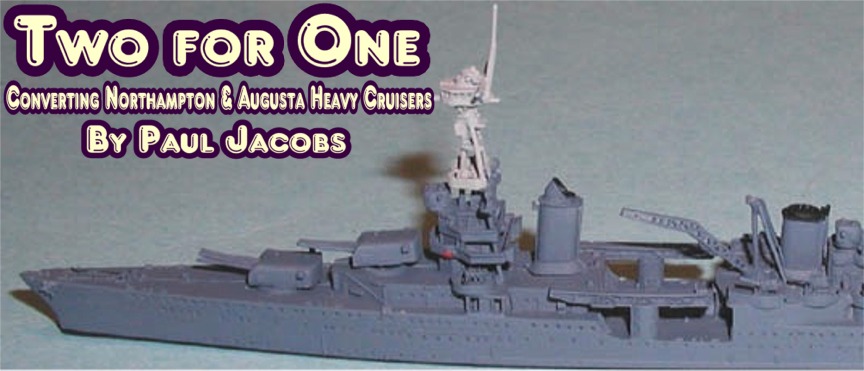 |
TWO FOR ONE Two easy conversions from two different models
|
 |
TWO FOR ONE Two easy conversions from two different models
|
The six U.S. Navy cruisers of the inter-war Northampton Class fell into two sub-groups: Northampton, Chester and Louisville in one, and Augusta, Chicago and Houston in the other. The difference could be found in the elongated forecastle of the latter group, which enabled them to serve as fleet flagships. All six ships saw substantial service during the 1930's and in World War II, Houston and Northampton being sunk in 1942 and Chicago in 1943. All members of the class received repeated and sometimes substantial modifications both before and during the war. A number of models of these ships have been made by companies such as Wiking, Bassett-Lowke, Comet, Framburg, Superior, and Argonaut, but two of the Neptun models, which depict Chicago (N 1335) and Northampton (N 1335a) in pre-war states proved most satisfactory for me for simple conversions to other sister ships. The easiest of the two modifications was the Northampton. This Neptun model depicts the ship as she appeared after her fore funnel received an extension in 1935, which was unique among all the ships in the class. Otherwise the ship appears similar to her sub-group sisters. By removing the funnel extension, the ship can thus be made to represent either Chester or Louisville in the mid 1930's. To do this, I first used a small circular saw bit on my Dremel tool and carefully cut off the funnel cap. Preserving the cap, I then cut off the extension at the base, filed it flat and then, having cleaned the base of the cap, glued the cap onto the funnel. If done carefully, one can actually avoid having to repaint the model, other than to touch up the cap with black paint.
The Chicago conversion was more complicated. The Neptun model depicts the ship after various modifications were made in 1940. It incorporates the various King Board modifications initiated in 1940, such as added 5-inch guns, 1.1-inch guns, splinter shields and Mk 19 armored directors. These improvements were made to all of the ships over time, but by December 1941, most of the ships, except perhaps Houston had undergone some further changes. Augusta was the last ship to be given the King Board improvements and because of that, apparently the first to have a new heavier type mainmast which was installed in early 1941. In constructing the new mainmast, the after Mk 19 director was sited atop it, rather than immediately abaft the after funnel as in the other ships, and the searchlights were relocated from the mainmast to the platform abaft the after funnel where the director was located on the other ships. Eventually all of the ships, except Houston, would receive this new type of mast and the searchlights and director relocated accordingly, although with some minor differences from one ship to another, (such as searchlights located around the funnel instead of abaft it). This profile became characteristic for all the ships (except Houston) by late 1942 and throughout 1943. The Comet identification model shown here (with the name Northampton engraved on the port side) depicts this characteristic appearance.
By late 1943, however, significant changes were needed to correct overloading from the added weight of anti-aircraft and other wartime measures, and the three surviving ships gradually underwent changes that significantly altered their appearance, as foremasts were reduced, mainmasts made into simple light tripods mounted on the aft funnel, and in some cases one of two catapults removed. Louisville had these modifications made from October to December 1943, but Augusta and Chester appear not to have had this done until 1945. The easiest conversion of the Neptun Chicago is to Augusta circa 1941. To accomplish this it became necessary to remove the mainmast and build a new one. The new mast was made using Evergreen Styrene and Plastruct rod. The Mk 19 director was removed from abaft the funnel and placed atop the new mast. The searchlights from the old tripod were saved and relocated abaft the funnel. Life rafts were added to the turrets and a Navalis photo-etched CXAM radar screen installed. Once completed the ship was painted in Ms 12 as she appeared in the latter part of 1941. Both these conversions will make relatively easy additions to your fleet.
| Useful sources for drawings and
information: US. CRUISERS, An Illustrated Design History, by Norman Friedman, Naval Institute Press, 1984. CRUISERS OF THE U.S. NAVY 1922-1962, by Stefan Terzibaschitsch. Naval Institute Press 1984.
|
| _____________________________________________________________________________________________ |